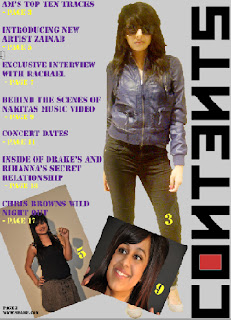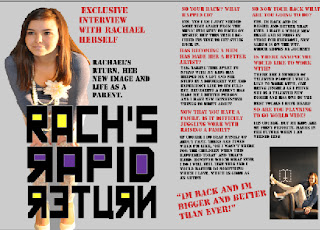Saturday, 31 December 2011
Questionnaire
This video is evidence of how my mind was made up and what influenced me when creating my magazine. When creating my own magazine i wanted it to be as successful as it can be, therefore i have done some background research. My chosen genre is girly RNB/hip hop, therefore i made a questionnaire and presented it to fellow students within my school as they are the main target audience that i wish to appeal too. I printed off various front covers of current hip hop/RNB, such as rap up, Billboard and vibe and got feedback on what was liked about each cover. I then Chose typefaces that are commonly used on music magazines and what i would consider to use, however as my magazine would be sold to my target audience i decided to get their opinion on the typefaces and use the most popular choice. Another question presented to the target audience i how often they buy and magazine and where from, this gives me an insight on how much to base my own magazine around and where commonly they are sold, therefore expanding my knowledge on the magazine distribution process. Within the magazine interesting topics need to be embedded, therefore one question was "what interests you most in a magazine", this allows me to see what to feature within my magazine, one of the choices were "interview with celebrities", this was a popular answer, which is why when creating my magazine a celebrity interview was decided to be feature on my double page spread.
Friday, 30 December 2011
Case Study
This is evidence to show my research of an institution - NME... this shows all background research and history and where NME is recognisable
Behind the scenes
This is a test shot showing images that i considered using, when creating my contents page i wanted insert images of this main model, this is evidence showing the experiments made. However this images wasnt successful as the model isnt showing much facial expression and there is a gap in her fringe.
For my double page spread i wanted one whole image of this model, this is one position i experimented with, this image allows the model to be "thinking" and not giving direct eye contact. However when chosing my image i didnt feel this image was successful as the model seems lifeless and not focused
This is another image, this is an improvement from the last image as the model is now smiling and looking at the camera, however this position wasnt successful.
This is another position i made the model try, however this image wasnt successful as the model wasnt ready and the camera shot wasnt good as you can see the setting in the background.
This is another image i tried, i wanted the model to look cool and casual, however certain elements ruined the picture, for example: the models shadow is in the way and the background that they are posing in front of creased and torn.
Thia is an image i thought it could use for my front cover, however the shot type isnt good as it is too far away and the lighting shown isnt appealing and doesnt show the model in a effective way
This is another image that was considered for the double page, however the lighting is too dark, making the picture lose its quality
This is an image i was considering to use, as you can see i have editted the image, took away the background, however this is not to final image i decided to go with as i thought it wasnt the best image taken
Image Planning:
In order to take my pictures i have created a table to record all my ideas of how I would like each image to turn out. I have included where it will be taken, at what time and what will be needed. This keeps me organised and help me remember what i need to bring along with me and allows me to book out the locations needed
Front cover picture planning
Contents page picture planning
Double page picture planning
Final product
This is the final product of my magazine, as you can see i have followed my plans and have created a successful magazine which follow existing layout and conventions, yet have put my own stamp on the product.
Conclusion:
Whilst researching different magazines I have discovered various constantly used elements which allow magazines to be appealing and successful. Taking ideas from existing magazines, i will try and incorporate these ideas into my own magazine, yet also challenge conventions.
conventions:
- After analysing magazine, I noticed that most coverlines are found on the left third (The Rule of Thirds), this is because the focus is mainly always there, and therefore important information is demonstrated here.
- The masthead is always located at top of each page. It is larger than the rest of the text and is presented in bold, making it noticeable and stand out. Billboard, Vibe and rap up all have bold block letters, they don’t appear “girly”, it appears to be strong and dominant, taking charge of the page. It tends to be simple and easy to read, therefore not confusing the reader or making them misunderstand what is being shown
- After analysing magazine, I noticed that most coverlines are found on the left third (The Rule of Thirds), this is because the focus is mainly always there, and therefore important information is demonstrated here.
- The models used are usually dressed depending on the genre, in the magazines I have looked at the models are all dressed up and wear jewellery which are commonly displayed conventions
- Each magazine provides a barcode, dateline, website and a price. This are displayed to provide the reader with information the reader wants to know
- The images used are of popular artists that the magazine genre cater for. The images are shown in different ways, normally on the contents page, montage of images are displayed, this is done to match images to the information. Normally there is a main image of an artist on the front cover and will contain small insert images of another artists.
- The colour scheme used it fairly simple and consists of three main colours – therefore not taking too much attention away from the information and does not overcrowd the reader. Colours used are not to bright for the reader, conventional colours include: Black, White, Red, Blue....
- Each magazine provides a barcode, dateline, website and a price. This are displayed to provide the reader with information the reader wants to know.
- Page numbers are constantly shown on every page – making it easier to navigate around the magazine
- The double page spread always consists of one main image along with various amounts of text and has the magazines name and website located at the bottom. It also shows to have pull out quotes and images
- Both contents pages have page numbers next to each image which link to the writing, this is done with the reader in mind as it makes it easier to navigate the magazine
- The target audience for the magazines are young males and females; this is because of the genre and the artists used.
- What is featured on the front page, is a what the double page spread features
After analysing these big known successful magazines, I have gained ideas on how I can incorporate existing ideas into my magazine.
- The main image on the front cover will be big and dominant the page
- The masterhead will be big and in a bold capital font, yet will still be unique
- Coverlines will be located on the left of the magazineThere will be a constant use of three colours throughout the magazineThere will be one main image on the double page spreadPullout quotes will be usedthe contents page will have a montage of images which will be numbered according to the page numbersPage numbers, website and magazine will be present on each pageBarcode and price will be shown along with the issue number
Wednesday, 28 December 2011
Subscribe to:
Comments (Atom)

















